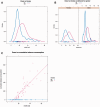Parsing the differences in affected with LHON: genetic versus environmental triggers of disease conversion
- PMID: 26657166
- PMCID: PMC6080496
- DOI: 10.1093/brain/awv339
Parsing the differences in affected with LHON: genetic versus environmental triggers of disease conversion
Figures



Comment in
-
Reply: Parsing the differences in affected with LHON: genetic versus environmental triggers of disease conversion.Brain. 2016 Mar;139(Pt 3):e18. doi: 10.1093/brain/awv340. Epub 2015 Dec 10. Brain. 2016. PMID: 26657167 Free PMC article. No abstract available.
Comment on
-
Mitochondrial optic neuropathies - disease mechanisms and therapeutic strategies.Prog Retin Eye Res. 2011 Mar;30(2):81-114. doi: 10.1016/j.preteyeres.2010.11.002. Epub 2010 Nov 26. Prog Retin Eye Res. 2011. PMID: 21112411 Free PMC article. Review.
References
-
- Barboni P, Savini G, Valentino ML, La Morgia C, Bellusci C, De Negri AM, et al. Leber's hereditary optic neuropathy with childhood onset. Invest Ophthalmol Vis Sci 2006; 47: 5303–9. - PubMed
-
- Bianco A, Martínez-Romero I, Bisceglia L, D'Agruma L, Favia P, Ruiz-Pesini E, et al. Mitochondrial DNA copy number differentiates the Leber’s hereditary optic neuropathy affected individuals from the unaffected mutation carriers. Brain 2015. Advance Access published on July 24, 2015, doi: 10.1093/brain/awv216. - PubMed
Publication types
MeSH terms
Grants and funding
LinkOut - more resources
Full Text Sources
Other Literature Sources

